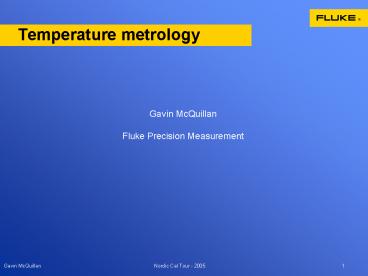Temperature metrology - PowerPoint PPT Presentation
1 / 24
Title:
Temperature metrology
Description:
This means that whatever the measured property of the device, that property ... we use Mathcad ITS-90 reduction software. also produces interpolation tables ... – PowerPoint PPT presentation
Number of Views:355
Avg rating:3.0/5.0
Title: Temperature metrology
1
Temperature metrology
Gavin McQuillan Fluke Precision Measurement
2
Temperature metrology
- Properties of thermometers
- Sensor types
- Why calibrate
- Calibration techniques
3
Properties of a thermometer
- It must be reproducible
- This means that whatever the measured property
of the device, that property should have the same
value (or very nearly so) whenever the
temperature is the same
- It must be insensitive to things other than
temperature - This means that whatever the measured property
of the device, that property should not depend on
factors such as the humidity or pressure, or on
the materials of which it is made, or on special
properties of the thing being measured such as
its colour or size
- It should be convenient to use
- Factors such as size, cost, speed of response,
ruggedness, immunity to electrical interference,
etc, will be important to varying degrees in
different applications
- It must be calibrated
- This means that we must know how to convert the
measured property (length, resistance, etc) to
temperature
4
Properties of a thermometer
- Platinum resistance thermometer or a thermistor -
the property measured is the electrical
resistance of a piece of 'sensing' material - Thermocouple - the property measured is the
voltage generated along the wires making up the
thermocouple
5
Why calibrate ?
- Provides confidence that the instrument has been,
and is, operating to the manufacturers
specification - Ensures compliance with quality systems and
industry regulations - Provides traceability to your measurements
- In case of higher accuracy sensors calibration is
actually characterisation
6
Sensor types
SPRTs 0.00035oC at Ga
Secondary standard PRTs 0.005oC
Thermistors 0.01oC
PRTs 0.1oC
Thermocouples 1.5oC
7
Calibration equipment
- Factor of 5000 difference between most and least
accurate sensors - No one set up will be suitable for all sensors
- Uncertainty required determines calibration system
8
Calibration uncertainty
Total Calibration Uncertainty (RSS)
A Reference probe accuracy B Reference
probe readout accuracy C Temperature source
stability D Temperature source uniformity
calibration accuracy and short term drift
9
Calibration system
- High stability isothermal heat source
- Reference SPRTs or PRTs
- Readout for measurement of SPRTs and UUTs
- Software for generation of calibration
coefficients and interpolation tables
10
Calibration methods
- Absolute Method
- The Unit Under Test is subjected to a physically
defined standard such as a repeatable phenomenon
of nature - Comparison Method
- The Unit Under Test is compared against another
measuring device of known and superior accuracy
11
SPRT Calibration
- SPRT is defined by ITS-90
- Absolute method of calibration
- Calibrated using
- ITS-90 defined fixed points
- resistance ratio measurements made with bridge
- Calibration is actually characterisation
- resistance readings fitted to a mathematical
expression - we use Mathcad ITS-90 reduction software
- also produces interpolation tables
12
ITS-90 ranges
13
SPRT Calibration
14
SPRT Calibration - coefficients
15
PRT calibration
- Probes as close together as is practical
- Preferably in radial pattern reference at
centre - Sensing elements on same horizontal plane
- Wait for equilibrium
Disadvantages
- Time consuming
- DMMs do not allow input of unique cal
coefficients - Need to use look up tables or software
- Does not provide real time temperature data
- Unstable heat source will introduce errors due to
delay in temperature calculations - Two DMMs quicker but still have conversion delays
16
PRT calibration
A better method
- All probes connected to readout
- Readout controls measurement and scanning
- Built in conversions direct temperature reading
- Can be software controlled
17
PRT characterisation
High accuracy use ITS-90 fit Medium
accuracy Callendar van Dusen (CVD) simpler
mathematics Basis of temperature scales of 1927,
1948 and 1968 Limitations on precision of
fit History, simplicity and suitability make it
preferred fit for medium accuracy Low
accuracy Not characterisation but tolerance
testing Does it conform to DIN curve Class A
0.15 (0.002.t)oC Class B 0.30 (0.003.t)oC
18
Thermistor characteristics
- All accuracy levels
- Semiconductor sensor
- Narrow temperature range (-50 to 200 C)
- Exponential with high sensitivity
- Negative TCR
- Stable over time and temperature
19
Thermistor calibration
- Comparison calibration as for PRTs
- Use Metrology Well or bath depending on accuracy
- Characterisation for medium to high accuracy
- Third order polynomial exponential curve
- Steinhart-Hart equation
- Tolerance testing at low accuracy
20
Thermocouple characteristics
- All accuracy levels
- Constructed from dissimilar metals
- Bare wire or probe configurations
- Wide temperature range (-200 to 2000 C)
- Relatively linear with low sensitivity
- Actually produce a voltage
- Most types not stable over time and temperature
21
Thermocouple calibration
- Comparison calibration
- Use industrial dry well, Metrology Well or bath
depending on accuracy - Bare wire or probe configuration will also
determine heat source - Use a reference PRT (SPRT for Pt-Au T/Cs)
- Readout
- Unless using a reference thermocouple two
readouts will be required or use 1529/1560 - Generally tolerance testing to conform to
thermocouple type
22
Automated calibration
All techniques described have one major
disadvantage
TIME CONSUMING
23
Calibration software
- Automated or semi-automated calibration
- Calculate calibration coefficients
- Generate interpolation tables
- Print calibration certificate
24
Questions
?































